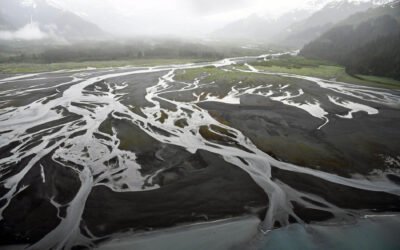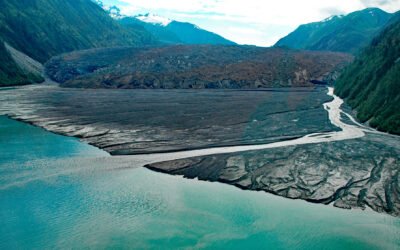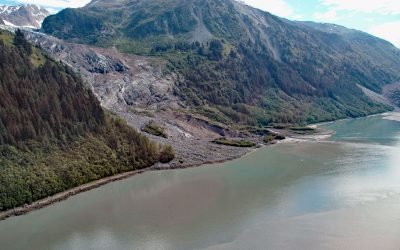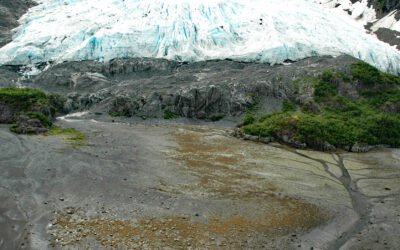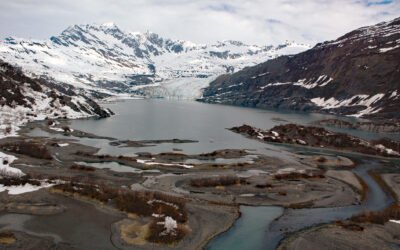Glaciers
Recent Articles
More Articles
Sudden Stream, Malaspina Coastal Plain
Sudden Stream drains the Malaspina Coastal Plain, flowing generally south for 2 miles (3.2 km) from the outlet of Malaspina Lake, a proglacial lake at the terminus of the Malaspina Glacier, to a lagoon formed by a barrier spit called Schooner Beach on Yakutat Bay, about 207 miles (333 km) east-southeast of Cordova and 18 miles (29 km) northwest of Yakutat, Alaska.
Nuka River, Beauty Bay
Nuka River starts from Bradley Pass in the Kenai Mountains at an elevation of roughly 1400 feet (427 m) and flows generally south for 10 miles (16 km), draining a watershed of 34,503 acres (13,963 ha), to Beauty Bay between Storm Mountain to the north and Mount Diablo to the south in West Arm Nuka Bay, about 57 miles (92 km) southwest of Seward and 32 miles (52 km) east-southeast of Homer, Alaska.
North Crillon Glacier, Lituya Bay
North Crillon Glacier starts from a cirque at an elevation near 6,200 feet (1,890 m) on the west flank of Mount Crillon in the Fairweather Range, and flows generally southwest for 9 miles (15 km) and then makes an abrupt turn to the north and continues for another 3 miles (5 km) to the head of Lituya Bay, about 100 miles (161 km) southeast of Yakutat and 65 miles (105 km) west-northwest of Gustavus, Alaska.
Cascade Glacier, Lituya Bay
Cascade Glacier starts from the western slope of Peak 7788 (2,374 m) in the Fairweather Range and flows generally west for 2.6 miles (4 km) to the head of Lituya Bay in Glacier Bay National Park and Preserve, about 97 miles (156 km) southeast of Yakutat and 67 miles (108 km) northwest of Gustavus, Alaska.
Lawrence Glacier, Blackstone Bay
Lawrence Glacier starts from several cirques situated at the northern extent of the Kenai Mountains at an elevation of roughly 3,000 feet (915 m) and flows generally northwest for 2.4 miles (4 km) to within a few hundred feet of tidewater at the south end of Willard Island in Blackstone Bay, about 84 miles (135 km) west-southwest of Valdez and 7 miles (11 km) south-southeast of Whittier, Alaska.
Rendu Glacier, Glacier Bay National Park and Preserve
Rendu Glacier starts in the Fairweather Range at an elevation of roughly 4600 feet (1400 m) in British Columbia and flows generally southeast for about 1 mile (1.6 km) to the United States border between Mount Barnard to the southwest and Boundary Peak 159 to the northeast, and then continues for another 12 miles through Glacier Bay National Park and Preserve to Rendu Inlet, about 113 miles (182 km) southeast of Yakutat and 54 miles (87 km) north-northwest of Gustavus, Alaska.
Pedersen Lagoon, Aialik Bay
Pedersen Lagoon receives freshwater from proglacial lakes of the Addison and Pedersen glaciers that descend from the Harding Icefield in Kenai Fjords National Park on the western shore of Aialik Bay, about 64 miles (103 km) east-northeast of Homer and 19 miles (31 km) south-southwest of Seward, Alaska.
Gilman Glacier, Johns Hopkins Inlet
Gilman Glacier starts at an elevation of roughly 6,000 feet (1,828 m)in the Fairweather Range of the Saint Elias Mountains and flows generally northwest for 7.5 miles (12 km) to Johns Hopkins Inlet in Glacier Bay National Park and Preserve, about 105 miles (169 km) southeast of Yakutat and 58 miles (93 km) northwest of Gustavus, Alaska.
Shoup Glacier, Port Valdez
Shoup Glacier starts at an elevation of roughly 6,800 feet (2,073 m) in the Chugach Mountains between Mount Shouplina to the west and Mount Logan to the east, and flows 16 miles (26 km) generally south-southwest to Shoup Bay on the northwest shore of Port Valdez in Prince William Sound, about 74 miles (119 km) east-northeast of Whittier and 9 miles (15 km) west of Valdez, Alaska.
Dinglestadt Glacier, Kenai Fjords National Park
Dinglestadt Glacier has two land terminating lobes that straddle a watershed divide in the Kenai Mountains, with a minor lobe descending southeast for 4 miles (6 km) from an elevation of roughly 3300 feet (1006 m) to a tidal delta on the western shore of McCarty Glacier in Kenai Fjords National Park, about 44 miles (71 km) south-southwest of Seward and 42 miles (68 km) east of Homer, Alaska.
About the background graphic
This ‘warming stripe’ graphic is a visual representation of the change in global temperature from 1850 (top) to 2019 (bottom). Each stripe represents the average global temperature for one year. The average temperature from 1971-2000 is set as the boundary between blue and red. The colour scale goes from -0.7°C to +0.7°C. The data are from the UK Met Office HadCRUT4.6 dataset.
Click here for more information about the #warmingstripes.


